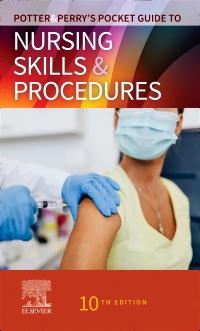
Potter & Perry’s Pocket Guide to Nursing Skills & Procedures - Elsevier eBook on VitalSource, 10th Edition
Elsevier eBook on VitalSource

Now $44.99
Put essential nursing skills and procedures at your fingertips! Based on Potter & Perry's bestselling textbook Clinical Nursing Skills & Techniques, this pocket guide provides quick access to 83 key nursing skills in a convenient, A-to-Z format. Step-by-step instructions include full-color photos plus rationales explaining why and how to use specific techniques, and also suggest nursing interventions for potential complications. The book’s portable size and spiral binding make it an ideal companion during clinical rotations. Reflecting the latest in evidence-based practice, this study tool and clinical reference helps you perform core nursing skills safely and effectively.
Newer Edition Available
Potter & Ostendorf’s Pocket Guide to Nursing Skills & Procedures - Elsevier eBook on VitalSource
-
- Authoritative content is based on and matches Perry, Potter, Ostendorf & Laplante’s Clinical Nursing Skills & Techniques, 10th Edition, making this book ideal as a quick, handy skills reference for information in the core text
- A-to-Z organization of skills makes it easy to find information quickly, with each skill beginning on a new page
- Clear, step-by-step instructions include the purpose for performing each skill, guidelines to help in delegating tasks to assistive personnel, lists of required equipment, and full-color photographs and drawings
- Concise two-column format for skills includes rationales for each step, providing the "what" and the "why" for performing the steps of each skill
- Unexpected Outcomes / Related Interventions provide troubleshooting information for common problems that may develop when performing a skill and also recommend appropriate actions
- Safety Alerts within the skills highlight important information for patient safety and effective performance of the skill
- Special Considerations address teaching, home care settings, and pediatric and geriatric patients, describing the risks or accommodations needed when caring for patients in these populations
- Gloving logo within the skills steps identifies circumstances in which clean gloves should be worn or gloves should be changed before proceeding to the next step of the skill
- Documentation guidelines provide bulleted lists of what should be reported and recorded in the patient records
- Convenient pocket-size format includes a back-cover flap for bookmarking and spiral binding, allowing the book to lay flat and stay open on the page being referenced
-
- NEW! New skills are added and all skills throughout the book are updated to match the latest evidence-based practice, guidelines, and standards — ensuring safe, effective performance of skills
-
1. Acapella Device
2. Aquathermia and Heating Pads
3. Aspiration Precautions
4. Assisting with Use of Canes, Walkers, and Crutches
5. Bladder Scan
6. Blood Administration
7. Blood Glucose Monitoring
8. Blood Pressure by Auscultation: Upper Extremities, Lower Extremities, Palpation
9. Blood Pressure: Automatic
10. Cardiac Monitor Application
11. Central Vascular Access Device CARE: Central and Peripherally Inserted
12. Chest Tube Insertion and Management
13. Cold Application
14. Condom and External Urinary Catheter
15. Continuous Subcutaneous Infusion
16. Dressings: Dry and Damp-to-Dry
17. Dressings: Hydrocolloid, Hydrogel, Foam, or Alginate Dressing
18. Dressings: Transparent Dressing
19. Ear Medications
20. Ear Irrigation
21. Obtaining a 12-Lead Electrocardiogram
22. Enema Administration
23. Enteral Nutrition: Nasogastric, Nasointestinal, Gastrostomy, or Jejunostomy Tube
24. Enteral Tube Insertion
25. Epidural Analgesia
26. Eye Irrigation
27. Eye Medications
28. Fall Prevention in a Health Care Facility
29. Fecal Impaction
30. Hypothermia and Hyperthermia Blankets
31. Using Incentive Spirometry
32. Intradermal Injections
33. Intramuscular Injections
34. Intravenous Medications by Piggyback and Syringe Pumps
35. Intravenous Medications: Intravenous Bolus
36. Isolation Precautions
37. Mechanical Lifts: Transfer Skills
38. Metered-Dose Inhalers (MDIs)
39. Moist Heat Applications (Compress and Sitz Bath)
40. Mouth Care for an Unconscious or Debilitated Patient
41. Nail and Foot Care
42. Nasogastric Tube Insertion for Gastric Decompression: Maintenance and Removal
43. Negative-Pressure Wound Therapy
44. Oral Medications
45. Oral Medications Administered Through a Feeding Tube
46. Ostomy Care (Colostomy and Ileostomy Pouching)
47. Oxygen Therapy
48. Parenteral Medication Preparation: Ampules and Vials
49. Parenteral Medication Preparation: Mixing Medications in One Syringe
50. Patient Controlled Analgesia
51. Peak Flowmeter
52. Peripheral Intravenous Care: Dressing Change and Discontinuation
53. Peripheral Intravenous Care: Regulating Intravenous Flow Rates and Changing Solutions
54. Peripheral Intravenous care: Short Catheter Insertion
55. Preoperative Teaching
56. Pressure Bandage
57. Pressure Injury Risk Assessment and Prevention
58. Pressure Injury Treatment
59. Pulse: Apical
60. Pulse Oximetry
61. Rectal Suppositories
62. Respiration Assessment
63. Restraint Application (Physical)
64. Restraint-Free Environment
65. Seizure Precautions
66. Sequential Compression Devices and Elastic Stockings
67. Sterile Gloving
68. Sterile Field Preparation
69. Subcutaneous Injections
70. Scutioning: Open and Closed for Nasotracheal/pharyngeal and Artificial Airways
71. Suctioning: Oropharyngeal
72. Suprapubic Catheter Care
73. Suture and Staple Removal
74. Topical Medications to the Skin
75. Tracheostomy Care
76. Urinary Catheter Insertion: Straight or Indwelling Catheter
77. Urinary Indwelling Catheter Care and Removal
78. Urinary Indwelling Catheter Irrigation
79. Urostomy Pouching
80. Vaginal Medications
81. Venipuncture: Collecting Blood Specimens and Cultures by Syringe and Vacutainer Method
82. Wound Drainage Evacuation
83. Performing a Wound Irrigation
Bibliography
Index


 as described in our
as described in our 